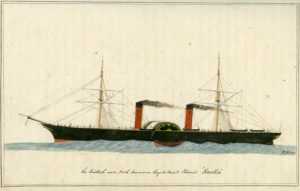The big guns are out, and they are aiming towards Asia and the Pacific.
Sure, the current hot proxy war between the US Empire and Russia happens to be in Europe but the big target is China, and the cold war to prevent its rise is warming by degrees with every day that passes.
For Australia – America’s “unsinkable aircraft carrier” and its “deputy sheriff” in the Pacific Region – the signs are all very ominous. The commandant of the US Marine Corps, General David Berger, was in Australia this week, urging the government to ramp up actions against China on all levels. China, he warned, was trying to advance its interests in the region without “tripping the wire to open conflict”.
Meanwhile, a bigger US deputy sheriff, NATO secretary general Jens Stoltenberg, has been doing a whistle-stop tour of key empire outposts in East Asia. He told reporters in Tokyo that any attempt by China to intervene militarily in Taiwan would have severe consequences, not only for Asia but for NATO and global security.
Stoltenberg and Japanese premier Fumio Kishida declared that the Ukraine war and Russia’s growing military co-operation with China had created the most tense security environment since the second world war. “The world is at a historical inflection point in the most severe and complex security environment since the end of World War II,” the two said in a statement. Stoltenberg said if Russia defeated Ukraine it would embolden China. “This war is not just a European crisis, but a challenge to the world order,” he said. Stoltenberg had earlier visited South Korea, warning there that a Ukraine-type crisis could emerge at any day.
Global hegemony
A NATO leader visiting Japan and Korea might once have seemed very strange. After all, NATO stands for North Atlantic Treaty Organisation, a grouping of European nations under US leadership created to counter the USSR (the Union of Soviet Socialist Republics). After the USSR fell NATO has been used to crush remnant Russia and is now being expanded to help the US maintain its global hegemony in the face of China’s threat to its dominance.
NATO has been expanding in Europe, absorbing former Soviet states and pushing US missiles closer and closer to Russia. The military integration of Ukraine with NATO – even before Ukraine could be formally absorbed – was the red line that forced Russia’s hand and provided the opportunity for the war, sanctions, sabotage and other measures now being used to demolish the former Soviet superpower. The use of Ukraine as a strategic prod to bring about this result had been war-gamed often in the past, notably by the US Rand Corporation, which saw it as an effective way to weaken Russia.
The war has also prompted previously “neutral” Finland and Sweden to apply for NATO membership, and has encouraged NATO members to massively boost military spending, deploy more troops and weapons and – most significantly – to begin a “pivot to Asia”, following the lead of the US in turning its strategic attention against the only country left in the world that has any chance of challenging US supremacy – China.
China is now being subjected to pressure on every available front, and NATO is a key part of the US-Empire strategy. Last year for the first time NATO explicitly named China as a security threat. Last year for the first time Japan and South Korea were invited to attend a NATO summit as observers. In the wake of that meeting both countries announced more military spending, more measures designed to contain China and more integration with the US-NATO network.
Japan – previously bound by its famous postwar defence-only constitution – has been encouraged to embark on a massive military expansion that will make it the world’s third biggest weapons spender, behind the USA and China.
South Korea has also vowed to throw even more weight behind the alliance against China. Also visiting Seoul in January was US defence secretary Lloyd Austin, who told South Koreans that: “The US stands firm in its extended deterrence commitment that includes the full range of US defence capabilities, including our conventional, nuclear and missile defence capabilities.” South Korea will host even more US ships, planes and missiles.
New US bases
It’s all part of a massive flurry of activity on many levels, designed to isolate and weaken China. On the military front, new US bases in the Philippines, a new US embassy in the Solomon Islands and more US troops and weapons in Australia. Even the battered former colonial great power, England, is determined to find a military role for itself in the Indo-Pacific, if and when push comes to shove.
On the economic front, more bans on Chinese companies and products and more restrictions on Chinese imports and exports. A few examples: Japanese corporations including Sony, Canon and Daikin have all begun shifting manufacturing out of China and into Empire-friendly nations such as Thailand, Foxconn is shifting investment to Mexico and Apple is planning to start making MacBooks in Vietnam. And that is just the tip of a very big iceberg of economic measures that include currency manipulation and cyberwarfare. On the propaganda front, few in the West can fail to have noticed the surge in anti-China propaganda across all media platforms.
For Australia the evolving situation is as tricky as it is for most other countries that had developed strong trading ties with China. Australia naturally wants to have its cake and eat it too, retaining profitable trade with China while also keeping the US happy by boosting its already deep integration with the Empire’s strategic network. “Buying” half-a-dozen nuclear submarines is one way of paying the required tribute. Hosting more bombers and marines is another. Australia has made it unambiguously clear that the minute the gloves come off and the war goes from cold to hot, its place will be by the side of the US, along with Japan, South Korea, the Philippines and all the other potentially front-line combatants.
The problem for China is serious. The intensity of its encirclement is now at a level not seen since the peak of the cold war between the USA and the USSR. It is extremely difficult to see how it can escape, much less achieve its dream of global leadership.
With the richest and most heavily armed countries in the world determined to keep it down, China may perceive itself running out of time and space for action. The longer it waits, the worse its position becomes – or so it seems. In the same way that Russia sees Ukraine and the Crimea as existential security issues so, perhaps, China may see Taiwan and the South China Sea as vital to its long-term interests. It is easy to see how China can be out-politicked on both potential flashpoints, forcing it to the same situation as Russia, where it has to choose between lashing out or lying down and waiting for the bullet.
That makes the Asia-Pacific a nervous place to be in 2023.



